Biosynthetic and Synthetic Strategies for Assembling Capuramycin-Type Antituberculosis Antibiotics
Abstract
1. Introduction
2. Discovery, Mechanism of Action, and Structure of Capuramycin-Type Nucleoside Antibiotics
3. Biosynthesis
3.1. Investigation of Precursors
3.2. Identification of the Gene Cluster
3.3. Functional Assignment of Gene Products
4. Chemical and Enzymatic Synthesis of Capuramycin and Analogs
4.1. Total Synthesis
4.2. Preparation of 1 Analogs
5. Prospects
Funding
Conflicts of Interest
References
- Global Tuberculosis Report 2017; World Health Organization: Geneva, Switzerland, 2017.
- Sarvi, F.; Momenian, S.; Khodadost, M.; Pahlavanzadeh, B.; Nasehi, M.; Sekhavati, E. The examination of relationship between socioeconomic factors and number of tuberculosis using quantile regression model for count data in Iran 2010–2011. Med. J. Islam. Repub. Iran 2016, 30, 399. [Google Scholar] [PubMed]
- Mesfin, Y.M.; Hailemariam, D.; Biadgilign, S.; Kibret, K.T. Association between HIV/AIDS and multi-drug resistance tuberculosis: A systematic review and meta-analysis. PLoS ONE 2014, 9, e82235. [Google Scholar] [CrossRef] [PubMed]
- Cheng, M.P.; Abou Chakra, C.N.; Yansouni, C.P.; Cnossen, S.; Shrier, I.; Menzies, D.; Greenaway, C. Risk of active tuberculosis in patients with cancer: A systematic review and meta-analysis. Clin. Infect. Dis. 2017, 64, 635–644. [Google Scholar] [CrossRef] [PubMed]
- Frieden, T.R.; Sterling, T.; Pablos-Mendez, A.; Kilburn, J.O.; Cauthen, G.M.; Dooley, S.W. The emergence of drug-resistant tuberculosis in New York City. N. Engl. J. Med. 1993, 328, 521–526. [Google Scholar] [CrossRef] [PubMed]
- Centers for Disease Control and Prevention, Emergence of Mycobacterium tuberculosis with extensive resistance to second-line drugs—Worldwide, 2000–2004. MMWR Morb. Wkly. Rep. 2006, 55, 301–305.
- Udwadia, Z.F.; Amale, R.A.; Ajbani, K.K.; Rodrigues, C. Totally drug-resistant tuberculosis in India. Clin. Infect. Dis. 2012, 54, 579–581. [Google Scholar] [CrossRef] [PubMed]
- Udwadia, Z.; Vendoti, D. Totally drug-resistant tuberculosis (TDR-TB) in India: Every dark cloud has a silver lining. J. Epidemiol. Community Health 2013, 67, 471–472. [Google Scholar] [CrossRef] [PubMed]
- Parida, S.K.; Axelsson-Robertson, R.; Rao, M.V.; Singh, N.; Master, I.; Lutckii, A.; Keshavjee, S.; Andersson, J.; Zumla, A.; Maeurer, M. Totally drug-resistant tuberculosis and adjunct therapies. J. Intern. Med. 2015, 277, 388–405. [Google Scholar] [CrossRef] [PubMed]
- Dong, M.; Pfeiffer, B.; Altmann, K.-H. Recent developments in natural product-based drug discovery for tuberculosis. Drug Discov. Today 2017, 22, 585–591. [Google Scholar] [CrossRef] [PubMed]
- Trofimov, V.; Costa-Gouveia, J.; Hoffmann, E.; Brodin, P. Host-pathogen systems for early drug discovery against tuberculosis. Curr. Opin. Microbiol. 2017, 39, 143–151. [Google Scholar] [CrossRef]
- Angala, S.K.; Belardinelli, J.M.; Huc-Claustre, E.; Wheat, W.H.; Jackson, M. The cell envelope glycoconjugates of Mycobacterium tuberculosis. Crit. Rev. Biochem. Mol. Biol. 2014, 49, 361–399. [Google Scholar] [CrossRef] [PubMed]
- Kim, P.S.; Makhene, M.; Sizemore, C.; Hafner, R. Viewpoint: Challenges and opportunities in tuberculosis research. J. Infect. Dis. 2012, 205 (Suppl. 2), S347–S352. [Google Scholar] [CrossRef] [PubMed]
- Khisimuzi, M.; Kaneko, T.; Upton, A. The tuberculosis drug discovery and development pipeline and emerging drug targets. Cold Spring Harb. Perspect. Med. 2015, 5, a021154. [Google Scholar]
- Bugg, T.D.; Walsh, C.T. Intracellular steps of bacterial cell wall peptidoglycan biosynthesis: Enzymology, antibiotics, and antibiotic resistance. Nat. Prod. Rep. 1992, 9, 199–215. [Google Scholar] [CrossRef] [PubMed]
- Bouhss, A.; Mengin-Lecreulx, D.; Le Beller, D.; Van Heijenoort, J. Topological analysis of the MraY protein catalysing the first membrane step of peptidoglycan synthesis. Mol. Microbiol. 1999, 34, 576–585. [Google Scholar] [CrossRef] [PubMed]
- Bouhss, A.; Crouvoisier, M.; Blanot, D.; Mengin-Lecreulx, D. Purification and characterization of the bacterial MraY translocase catalyzing the first membrane step of peptidoglycan biosynthesis. J. Biol. Chem. 2004, 279, 29974–29980. [Google Scholar] [CrossRef] [PubMed]
- Chung, B.C.; Zhao, J.; Gillespie, R.A.; Kwon, D.Y.; Guan, Z.; Hong, J.; Zhou, P.; Lee, S.Y. Crystal structure of MraY, an essential membrane enzyme for bacterial cell wall synthesis. Science 2013, 341, 1012–1016. [Google Scholar] [CrossRef] [PubMed]
- Chung, B.C.; Mashalidis, E.H.; Tanino, T.; Kim, M.; Matsuda, A.; Hong, J.; Ichikawa, S.; Lee, S.Y. Structural insights into inhibtion of lipid I production in bacterial cell wall synthesis. Nature 2016, 533, 557–660. [Google Scholar] [CrossRef] [PubMed]
- Ikeda, M.; Wachi, M.; Jung, H.K.; Ishino, F.; Matsuhashi, M. The Escherichia coli mraY gene encoding UDP-N-acetylmuramoyl-pentapeptide:undecaprenyl-phosphate phospho-N-acetylmuramoyl-pentapeptide transferase. J. Bacteriol. 1991, 173, 1021–1026. [Google Scholar] [CrossRef]
- Boyle, D.S.; Donachie, W.D. mraY is an essential gene for cell growth in Escherichia coli. J. Bacteriol. 1998, 180, 6429–6432. [Google Scholar] [PubMed]
- Thanassi, J.A.; Hartman-Neumann, S.L.; Dougherty, T.J.; Dougherty, B.A.; Pucci, M.J. Identification of 113 conserved essential genes using a high-throughput gene disruption system in Streptococcus pneumoniae. Nucleic Acid Res. 2002, 30, 3152–3162. [Google Scholar] [CrossRef] [PubMed]
- Otten, C.; Brilli, M.; Vollmer, W.; Viollier, P.H.; Salje, J. Peptidoglycan in obligate intracellular bacteria. Mol. Microbiol. 2018, 107, 142–163. [Google Scholar] [CrossRef] [PubMed]
- Muramatsu, Y.; Muramatsu, A.; Ohnuki, T.; Ishii, M.M.; Kizuka, M.; Enokita, R.; Tsutsumi, S.; Arai, M.; Ogawa, Y.; Suzuki, T.; et al. Studies on novel bacterial translocase I inhibitors, A-500359s. I. Taxonomy, fermentation, isolation, physico-chemical properties and structure elucidation of A-500359 A, C, D and G. J. Antibiot. 2003, 56, 243–252. [Google Scholar] [CrossRef] [PubMed]
- Muramatsu, Y.; Ishii, M.M.; Inukai, M. Studies on novel bacterial translocase I inhibitors, A-500359s. II. Biological activities of A-500359 A, C, D and G. J. Antibiot. 2003, 56, 253–258. [Google Scholar] [CrossRef] [PubMed]
- Muramatsu, Y.; Miyakoshi, S.; Ogawa, Y.; Ohnuki, T.; Ishii, M.M.; Arai, M.; Takatsu, T.; Inukai, M. Studies on novel bacterial translocase I inhibitors, A-500359s. III. Deaminocaprolactam derivatives of capuramycin: A-500359 E, F, H; M-1 and M-2. J. Antibiot. 2003, 56, 259–267. [Google Scholar] [CrossRef] [PubMed]
- Ohnuki, T.; Muramatsu, Y.; Miyakoshi, S.; Takatsu, T.; Inukai, M. Studies on novel bacterial translocase I inhibitors, A-500359s. IV. Biosynthesis of A-500359s. J. Antibiot. 2003, 56, 268–279. [Google Scholar] [CrossRef]
- Muramatsu, Y.; Ohnuki, T.; Ishii, M.M.; Kizuka, M.; Enokita, R.; Miyakoshi, S.; Takatsu, T.; Inukai, M. A-503083 A, B, E and F, novel inhibitors of bacterial translocase I, produced by Streptomyces sp. SANK 62799. J. Antibiot. 2004, 57, 639–646. [Google Scholar] [CrossRef] [PubMed]
- Muramatsu, Y.; Arai, M.; Sakaida, Y.; Takamatsu, Y.; Miyakoshi, S.; Inukai, M. Studies on novel bacterial translocase I inhibitors, A-500359s. V. Enhanced production of capuramycin and A-500359 A in Streptomyces griseus SANK 60196. J. Antibiot. 2006, 59, 601–606. [Google Scholar] [CrossRef] [PubMed]
- Murakami, R.; Fujita, Y.; Kizuka, M.; Kagawa, T.; Muramatsu, Y.; Miyakoshi, S.; Takatsu, T.; Inukai, M. A-102395, a new inhibitor of bacterial translocase I, produced by Amycolatopsis sp. SANK 60206. J. Antibiot. 2007, 60, 690–695. [Google Scholar] [CrossRef] [PubMed]
- Koga, T.; Fukuoka, T.; Doi, N.; Harasaki, T.; Inoue, H.; Hotoda, H.; Kakuta, M.; Muramatsu, Y.; Yamamura, N.; Hoshi, M.; et al. Activity of capuramycin analogues against Mycobacterium tuberculosis, Mycobacterium avium and Mycobacterium intracellulare in vitro and in vivo. J. Antimicrob. Chemother. 2004, 54, 755–760. [Google Scholar] [CrossRef] [PubMed]
- Yamaguchi, H.; Sato, S.; Yoshida, S.; Takada, K.; Itoh, M.; Seto, H.; Otake, N. Capuramycin, a new nucleoside antibiotic. Taxonomy, fermentation, isolation and characterization. J. Antibiot. 1986, 39, 1047–1053. [Google Scholar] [CrossRef] [PubMed]
- Seto, H.; Otake, N.; Sato, S.; Yamaguchi, H.; Takada, K.; Itoh, M.; Lu, H.S.M.; Clardy, J. The structure of a new nucleoside antibiotic, capuramycin. Tetrahedron Lett. 1988, 29, 2343–2346. [Google Scholar] [CrossRef]
- Isono, K. Nucleoside antibiotics: Structure, biological activity, and biosynthesis. J. Antibiot. 1988, 41, 1711–1739. [Google Scholar] [CrossRef] [PubMed]
- Elshahawi, S.; Shaaban, K.A.; Kharel, M.K.; Thorson, J.S. A comprehensive review of glycosylated bacterial natural products. Chem. Soc. Rev. 2015, 44, 7591–7697. [Google Scholar] [CrossRef] [PubMed]
- Kimura, K.; Bugg, T.D.H. Recent advances in antimicrobial nucleoside antibiotics targeting cell wall biosynthesis. Nat. Prod. Rep. 2003, 20, 252–273. [Google Scholar] [CrossRef] [PubMed]
- Winn, M.; Goss, R.J.M.; Kimura, K.; Bugg, T.D.H. Antimicrobial nucleoside antibiotics targeting cell wall assembly: Recent advances in structure-function studies and nucleoside biosynthesis. Nat. Prod. Rep. 2010, 27, 279–304. [Google Scholar] [CrossRef]
- Isono, K.; Asahi, K.; Suzuki, S. Studies on polyoxins, antifungal antibiotics. XIII. The structure of polyoxins. J. Am. Chem. Soc. 1969, 91, 7490–7505. [Google Scholar] [CrossRef]
- Chaudhary, P.M.; Tupe, S.G.; Deshpande, M.V. Chitin synthase inhibitors as antifungal agents. Mini Rev. Med. Chem. 2013, 13, 222–236. [Google Scholar]
- Isono, K.; Sato, T.; Hirawawa, K.; Funayama, S.; Suzuki, S. Biosynthesis of the nucleoside skeleton of polyoxins. J. Am. Chem. Soc. 1978, 100, 3937–3939. [Google Scholar] [CrossRef]
- Funabashi, M.; Nonaka, K.; Yada, C.; Hosobuchi, M.; Masuda, N.; Shibata, T.; Van Lanen, S.G. Identification of the biosynthetic gene cluster of A-500359s in Streptomyces griseus SANK60196. J. Antibiot. 2009, 62, 325–332. [Google Scholar] [CrossRef]
- Funabashi, M.; Yang, Z.; Nonaka, K.; Hosobuchi, M.; Fujita, Y.; Shibata, T.; Chi, X.; Van Lanen, S.G. An ATP-independent strategy for amide bond formation in antibiotic biosynthesis. Nat. Chem. Biol. 2010, 6, 581–586. [Google Scholar] [CrossRef] [PubMed]
- Liu, S.Y.; Rosazza, J.P.N. Enzymatic conversion of glucose to UDP-4-keto-6-deoxyglucose in Streptomyces spp. Appl. Environ. Microbiol. 1998, 64, 3972–3976. [Google Scholar] [PubMed]
- Liu, X.; Jin, Y.; Cui, Z.; Nonaka, K.; Baba, S.; Funabashi, M.; Yang, Z.; Van Lanen, S.G. The role of a nonribosomal peptide synthetase in l-lysine lactamization during capuramycin biosynthesis. ChemBioChem 2016, 17, 804–810. [Google Scholar] [CrossRef] [PubMed]
- Barnard-Britson, S.; Chi, X.; Nonaka, K.; Spork, A.P.; Tibrewal, N.; Goswami, A.; Pahari, P.; Ducho, C.; Rohr, J.; Van Lanen, S.G. Amalgamation of nucleosides and amino acids in antibiotic biosynthesis: Discovery of an l-threonine:uridine-5′-aldehyde transaldolase. J. Am. Chem. Soc. 2012, 134, 18514–18517. [Google Scholar] [CrossRef] [PubMed]
- Cai, W.; Goswami, A.; Yang, Z.; Liu, X.; Green, K.D.; Barnard-Britson, S.; Baba, S.; Funabashi, M.; Nonaka, K.; Sunkara, M.; et al. The biosynthesis of capuramycin-type antibiotics: Identification of the A-102395 biosynthetic gene cluster, mechanism of self-resistance, and formation of uridine-5′-carboxamide. J. Biol. Chem. 2015, 290, 13710–13724. [Google Scholar] [CrossRef] [PubMed]
- Yang, Z.; Chi, X.; Funabashi, M.; Baba, S.; Nonaka, K.; Pahari, P.; Unrine, J.; Jacobsen, J.M.; Elliott, G.I.; Rohr, J.; et al. Characterization of LipL as a non-heme, Fe(II)-dependent a-ketoglutarate: UMP dioxygenase that generates uridine-5′-aldehyde during A-90289 biosynthesis. J. Biol. Chem. 2011, 286, 7885–7892. [Google Scholar] [CrossRef] [PubMed]
- Goswami, A.; Liu, X.; Cai, W.; Wyche, T.P.; Bugni, T.S.; Meurillon, M.; Peyrottes, S.; Perigaud, C.; Nonaka, K.; Rohr, J.; et al. Evidence that oxidatvie phosphorylation by the nonheme Fe(II), α-ketoglutarate:UMP oxygenase occurs by stereospecific hydroxylation. FEBS Lett. 2017, 591, 468–478. [Google Scholar] [CrossRef]
- Huang, Y.; Liu, X.; Cui, Z.; Wiegmann, D.; Niro, G.; Ducho, C.; Song, Y.; Yang, Z.; Van Lanen, S.G. Pyridoxal-5′-phosphate as an oxygenase cofactor: Discovery of a carboxamide-forming, alpha-amino acid monooxygenase-decarboxylase. Proc. Natl. Acad. Sci. USA 2018, 115, 974–979. [Google Scholar] [CrossRef]
- Clifton, I.J.; Doan, L.X.; Sleeman, M.C.; Topf, M.; Suzuki, H.; Wilmouth, R.C.; Schofield, C.J. Crystal structure of carbepenem synthase (CarC). J. Biol. Chem. 2003, 278, 20843–20850. [Google Scholar] [CrossRef]
- Chang, W.C.; Guo, Y.; Wang, C.; Butch, S.E.; Rosenzweig, A.C.; Boal, A.K.; Krebs, C.; Bollinger, J.M. Jr. Mechanism of the C5 stereoconversion reaction in the biosynthesis of carbapenem antibiotics. Science 2014, 343, 1140–1144. [Google Scholar] [CrossRef]
- Martinez, S.; Hausinger, R.P. Catalytic mechanisms of Fe(II)- and 2-oxoglutarate-dependent oxygenases. J. Biol. Chem. 2015, 290, 20702–20711. [Google Scholar] [CrossRef] [PubMed]
- Yang, Z.; Funabashi, M.; Nonaka, K.; Hosobuchi, M.; Shibata, T.; Pahari, P.; Van Lanen, S.G. Functional and kinetic analysis of the phosphotransferase CapP conferring selective self-resistance to capuramycin antibiotics. J. Biol. Chem. 2010, 285, 12899–12905. [Google Scholar] [CrossRef] [PubMed]
- Liu, X.; Jin, Y.; Cai, W.; Green, K.D.; Goswami, A.; Garneau-Tsodikova, S.; Nonaka, K.; Baba, S.; Funabashi, M.; Yang, Z.; et al. A biocatalytic approach to capuramycin analogues by exploiting a substrate permissive N-transacylase CapW. Org. Biomol. Chem. 2016, 14, 3956–3962. [Google Scholar] [CrossRef] [PubMed]
- Knapp, S.; Nandan, S.R. Synthesis of capuramycin. J. Org. Chem. 1994, 59, 281–283. [Google Scholar] [CrossRef]
- Kurosu, M.; Li, K.; Crick, D.C. Concise synthesis of capuramycin. Org. Lett. 2009, 11, 2393–2396. [Google Scholar] [CrossRef] [PubMed]
- Wang, Y.; Kurosu, M. A new protecting group and linker for uridine ureido nitrogen. Tetrahedron 2012, 68, 4797–4804. [Google Scholar] [CrossRef] [PubMed]
- Wang, Y.; Siricilla, S.; Aleiwi, B.A.; Kurosu, M. Improved synthesis of capuramycin and its analogues. Chem. Eur. J. 2013, 19, 13847–13858. [Google Scholar] [CrossRef] [PubMed]
- Hotoda, H.; Furukawa, M.; Daigo, M.; Murayama, K.; Kaneko, M.; Muramatsu, Y.; Ishii, M.M.; Miyakoshi, S.-I.; Takatsu, T.; Inukai, M.; et al. Synthesis and antimycobacterial activity of capuramycin analogues. Part 1: Substitution of the azepan-2-one moiety of capuramycin. Bioorg. Med. Chem. Lett. 2003, 13, 2829–2832. [Google Scholar] [CrossRef]
- Hotoda, H.; Daigo, M.; Furukawa, M.; Murayama, K.; Hasegawa, C.A.; Kaneko, M.; Muramatsu, Y.; Ishii, M.M.; Miyakoshi, S.-I.; Takatsu, T.; et al. Synthesis and antimycobacterial activity of capuramycin analogues. Part 2: Acylated derivatives of capuramycin-related compounds. Bioorg. Med. Chem. Lett. 2003, 13, 2833–2836. [Google Scholar] [CrossRef]
- San Jose, G.; Jackson, E.R.; Haymond, A.; Johny, C.; Edwards, R.L.; Wang, X.; Brothers, R.C.; Edelstein, E.K.; Odom, A.R.; Boshoff, H.I.; et al. Structure-activity relationships of the MEPicides: N-acyl and O-linked analogs of FR900098 as inhibitors of Dxr from Mycobacterium tuberculosis and Yersinia pestis. ACS Inf. Dis. 2016, 2, 923–935. [Google Scholar] [CrossRef]
- Laborde, J.; Deraeve, C.; Bernardes-Génisson, V. Update of antitubercular prodrugs from a molecular perspective: Mechanisms of action, bioactivation pathways, and associated resistance. MedChemComm 2017, 12, 1657–1676. [Google Scholar] [CrossRef] [PubMed]
- Inukai, M.; Kaneko, M.; Takatsu, T.; Hotoda, H.; Arai, M.; Miyakoshi, S.; Kizuka, M.; Ogawa, Y. Preparation of A-500359 Derivatives as Antibacterial Agents. WO Appl. WO 2001014399A1, 20 March 2001. [Google Scholar]
- Hotoda, H.; Kaneko, M.; Inukai, M.; Muramatsu, Y.; Utsui, Y.; Ohya, S. Antibacterial Compound. U.S. Patent US 7,157,442 B2, 2 January 2007. [Google Scholar]
- Reddy, V.M.; Einck, L.; Nacy, C.A. In vitro antimycobacterial activities of capuramycin analogues. Antimicrob. Agents Chemother. 2008, 52, 719–721. [Google Scholar] [CrossRef] [PubMed]
- Nikonenko, B.V.; Reddy, V.M.; Protopopova, M.; Bogatcheva, E.; Einck, L.; Nacy, C.A. Activity of SQ641, a capuramycin analog, in a murine model of tuberculosis. Antimicrob. Agents Chemother. 2009, 53, 3138–3139. [Google Scholar] [CrossRef] [PubMed]
- Bogatcheva, E.; Dubuisson, T.; Protopopova, M.; Einck, L.; Nacy, C.A.; Reddy, V.M. Chemical modification of capuramycins to enhance antibacterial activity. J. Antimicrob. Chemother. 2011, 66, 578–587. [Google Scholar] [CrossRef] [PubMed]
- Dubuisson, T.; Bogatcheva, E.; Krishnan, M.Y.; Collins, M.T.; Einck, L.; Nacy, C.A.; Reddy, V.M. In vitro antimicrobial activities of capuramycin analogues against non-tuberculous mycobacteria. J. Antimicrob. Chemother. 2010, 65, 2590–2597. [Google Scholar] [CrossRef] [PubMed]
- Tallman, K.R.; Levine, S.R.; Beatty, K.E. Small-molecule probes reveal esterases with persistent activity in dormant and reactivating Mycobacterium tuberculosis. ACS Inf. Dis. 2016, 2, 936–944. [Google Scholar] [CrossRef] [PubMed]
- Moore, J.H.; van Opstal, E.; Kolling, G.L.; Shin, J.H.; Bogatcheva, E.; Nikonenko, B.; Einck, L.; Phipps, A.J.; Guerrant, R.L.; Protopopova, M. Treatment of Clostridium difficile infection using SQ641, a capuramycin analogue, increases post-treatment survival and improves clinical measures of disease in a murine model. J. Antimicrob. Chemother. 2016, 71, 1300–1306. [Google Scholar] [CrossRef] [PubMed]
- Kurosu, M.; Li, K. Synthetic studies towards the identification of novel capuramycin analogs with mycobactericidal activity. Heterocycles 2009, 77, 217–225. [Google Scholar] [CrossRef]
- Siricilla, S.; Mitachi, K.; Wan, B.; Franzblau, S.G.; Kurosu, M. Discovery of a capuramycin analog that kills nonreplicating Mycobacterium tuberculosis and its synergistic effects with translocase I inhibitors. J. Antibiot. 2015, 68, 271–278. [Google Scholar] [CrossRef] [PubMed]
- Nikonenko, B.; Reddy, V.M.; Bogatcheva, E.; Protopopova, M.; Einck, L.; Nacy, C.A. Therapeutic efficacy of SQ641-NE against Mycobacterium tuberculosis. Antimicrob. Agents Chemother. 2014, 58, 587–589. [Google Scholar] [CrossRef] [PubMed]
- Reddy, V.M.; Bogatcheva, E.; Einck, L.; A Nacy, C. Nanoemulsion formulation enhances intracellular activity of capuramycin analogues against Mycobacterium tuberculosis. Drug Deliv. Lett. 2011, 1, 150–158. [Google Scholar]
- Mutyam, S.K.; Bejugam, N.K.; Parish, H.J.; Reddy, V.M.; Bogatcheva, E.; Shankar, G.N. Permeability enhancing lipid-based co-solvent and SEDDS formulations of SQ641, an antimycobacterial agent. Pharm. Dev. Technol. 2015, 20, 598–607. [Google Scholar] [CrossRef] [PubMed]
- D’Addio, S.M.; Reddy, V.M.; Liu, Y.; Sinko, P.J.; Einck, L.; Prud’homme, R.K. Antitubercular nanocarrier combination therapy: Formulation strategies and in vitro efficacy for rifampicin and SQ641. Mol. Pharm. 2015, 12, 1554–1563. [Google Scholar] [CrossRef] [PubMed]
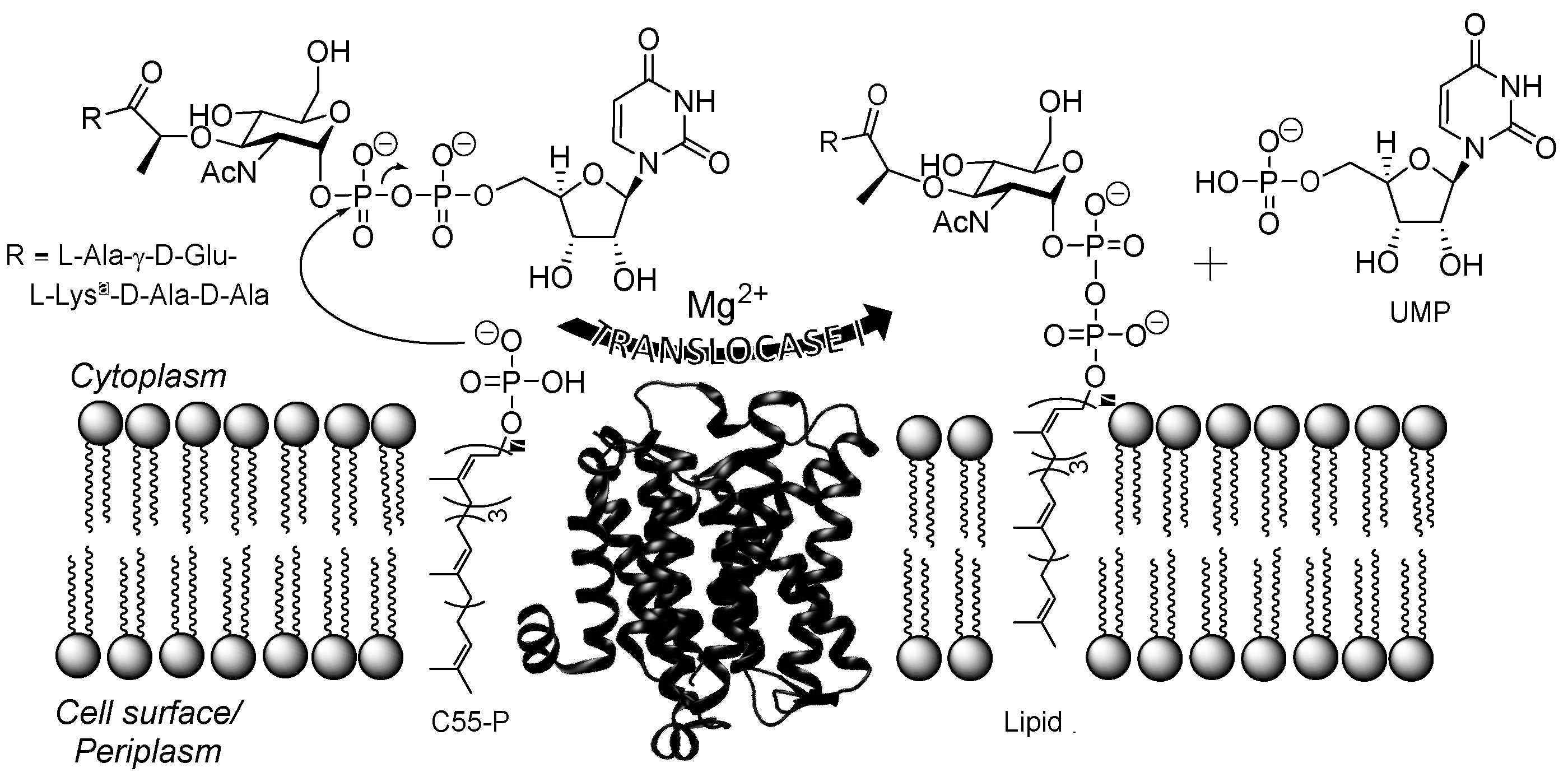
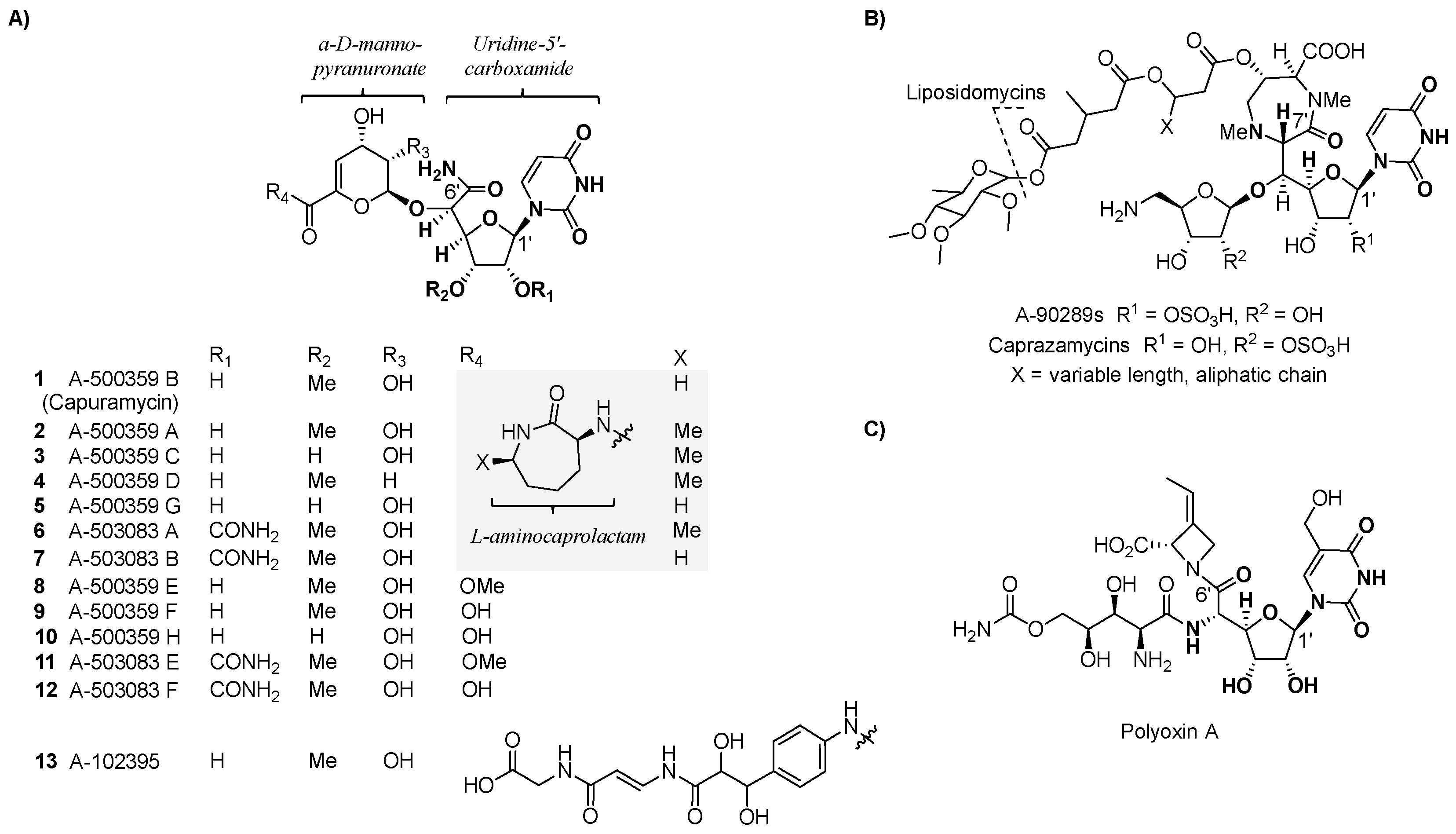


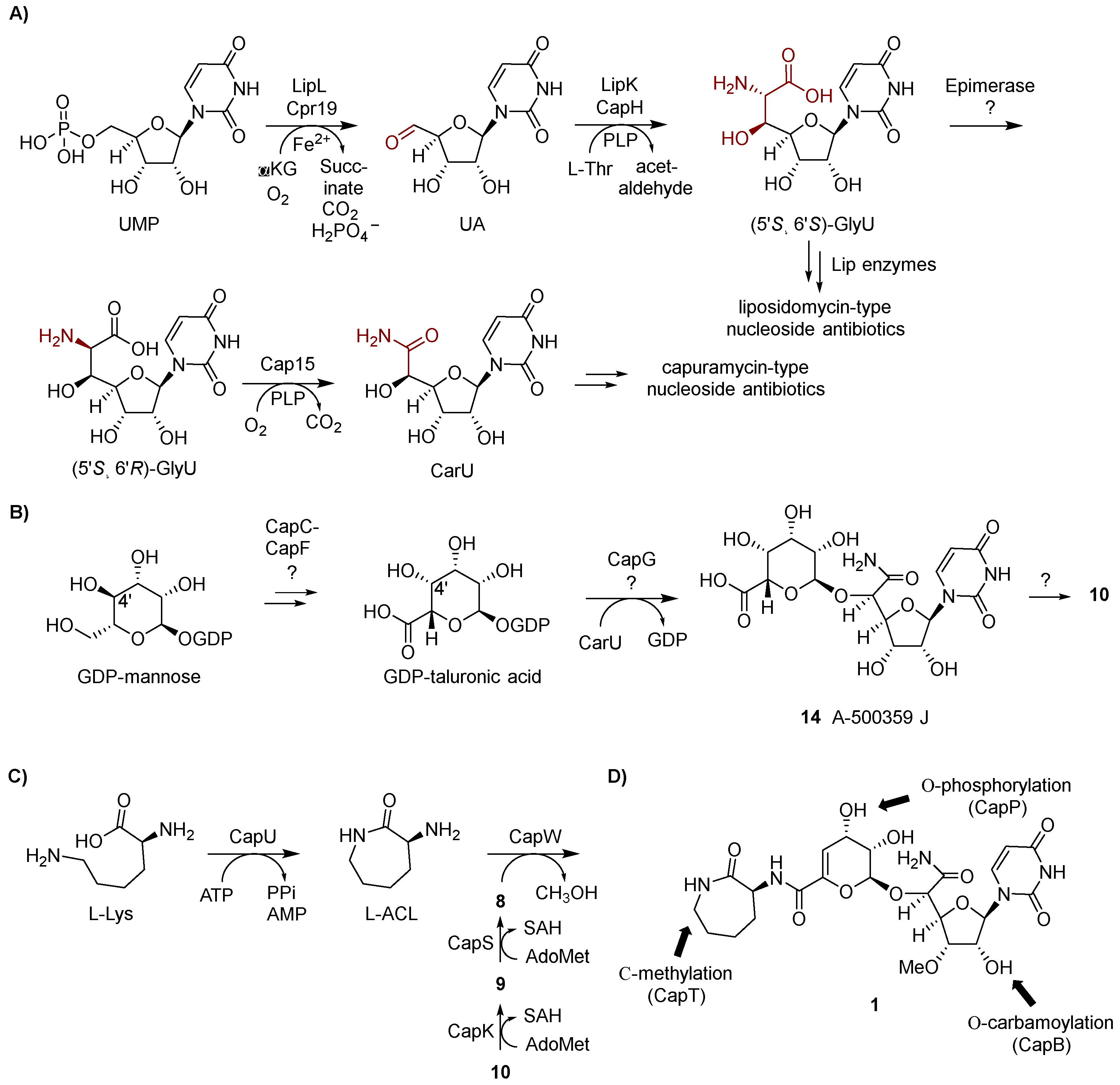
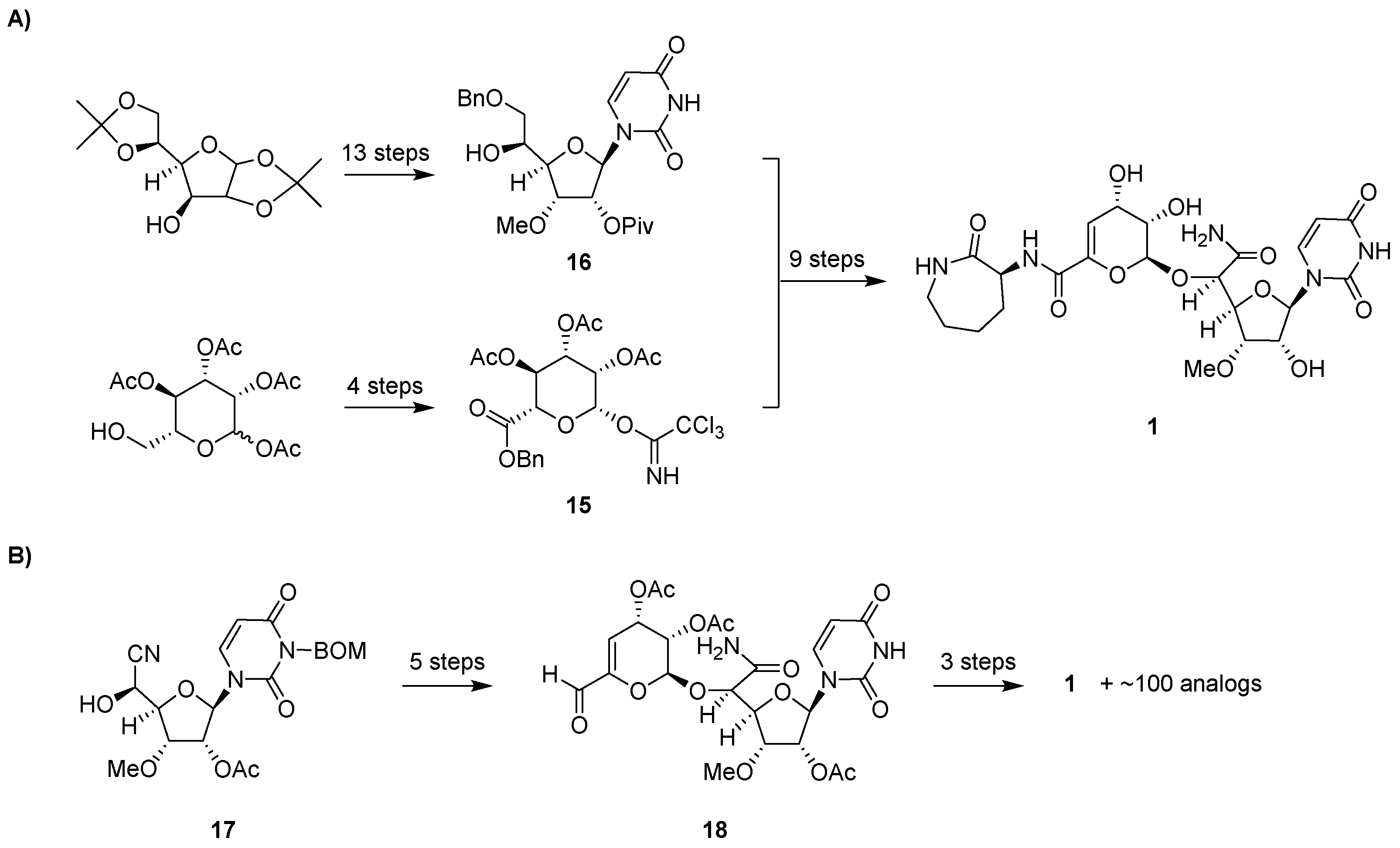
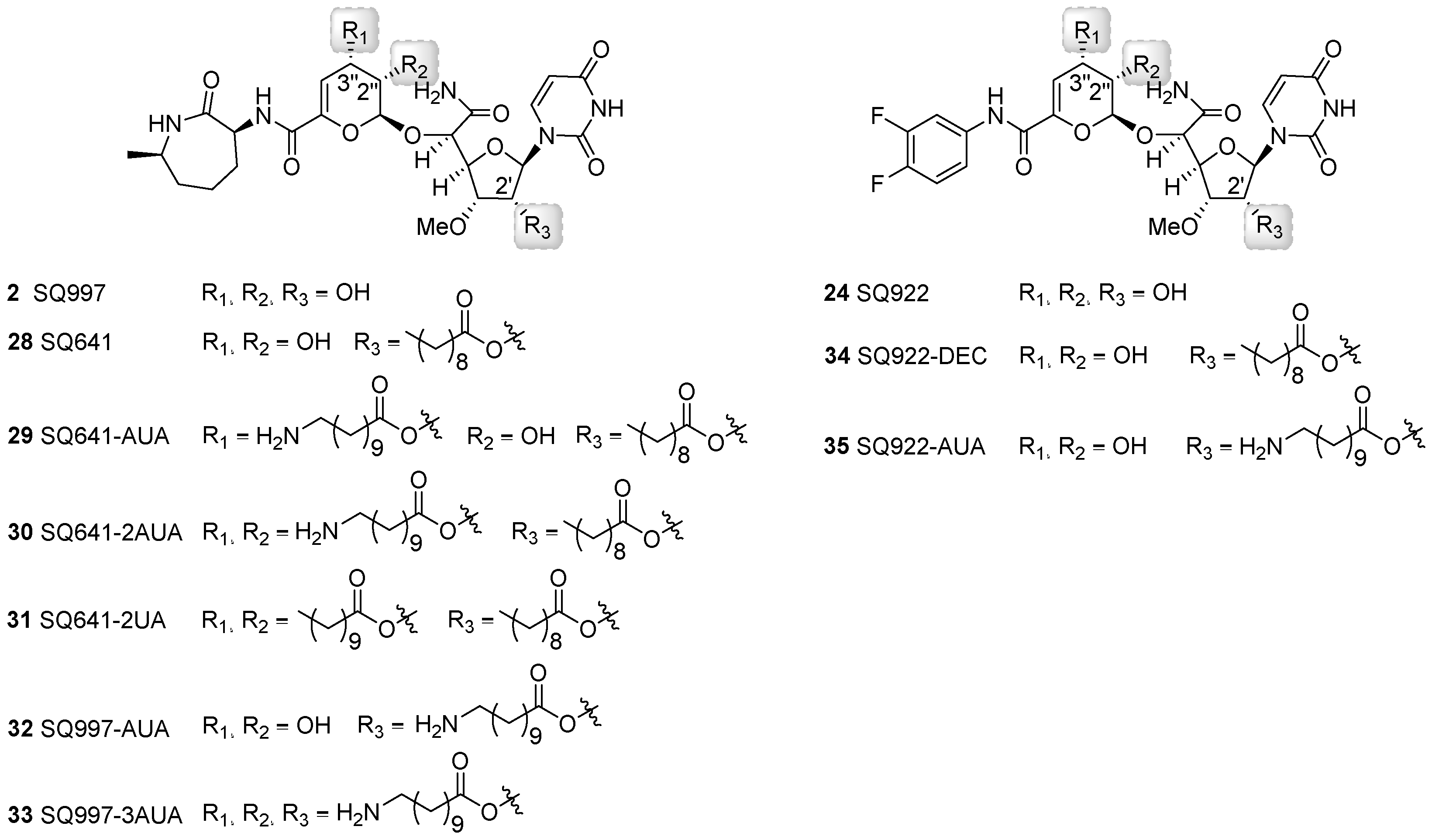
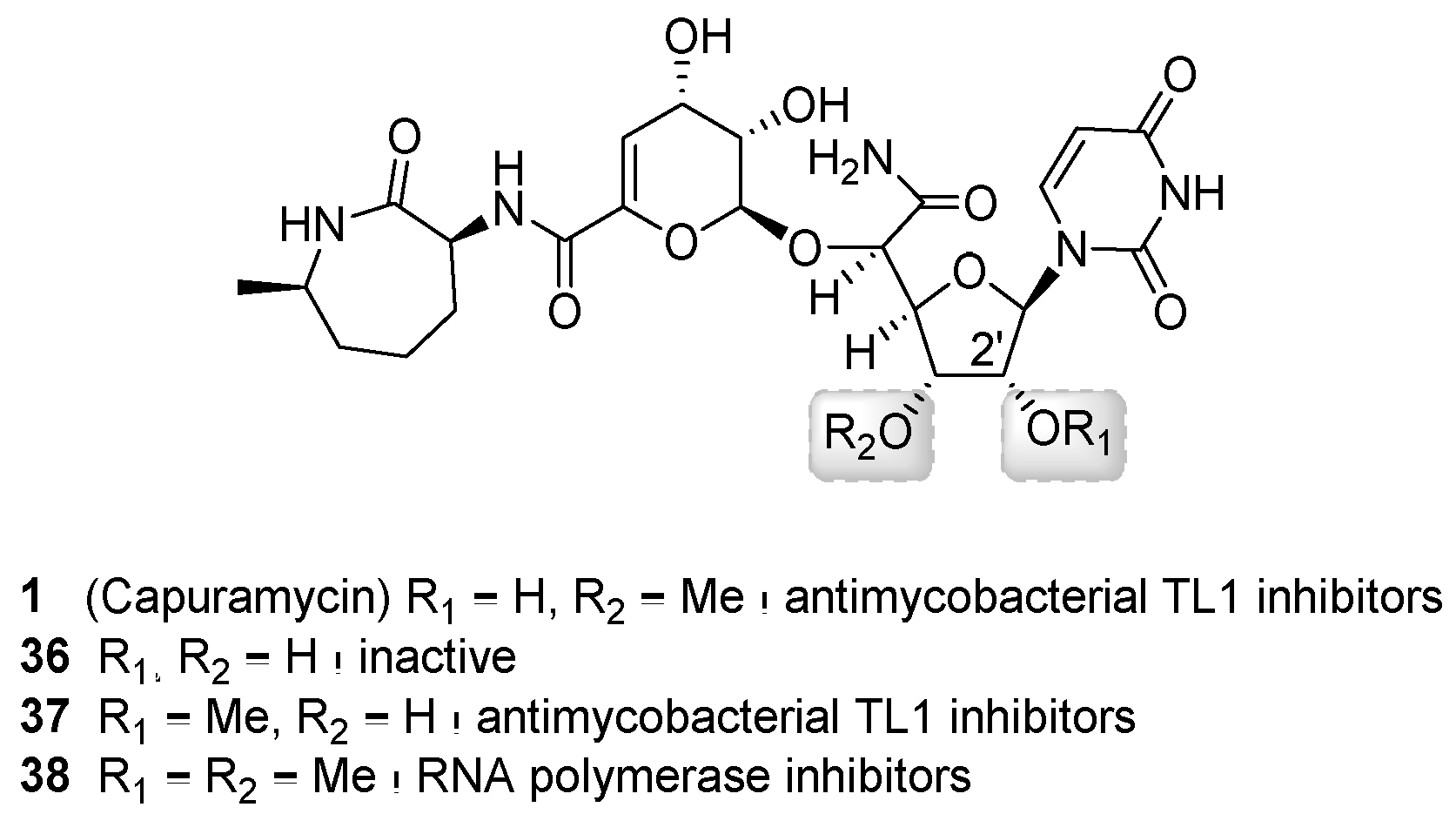
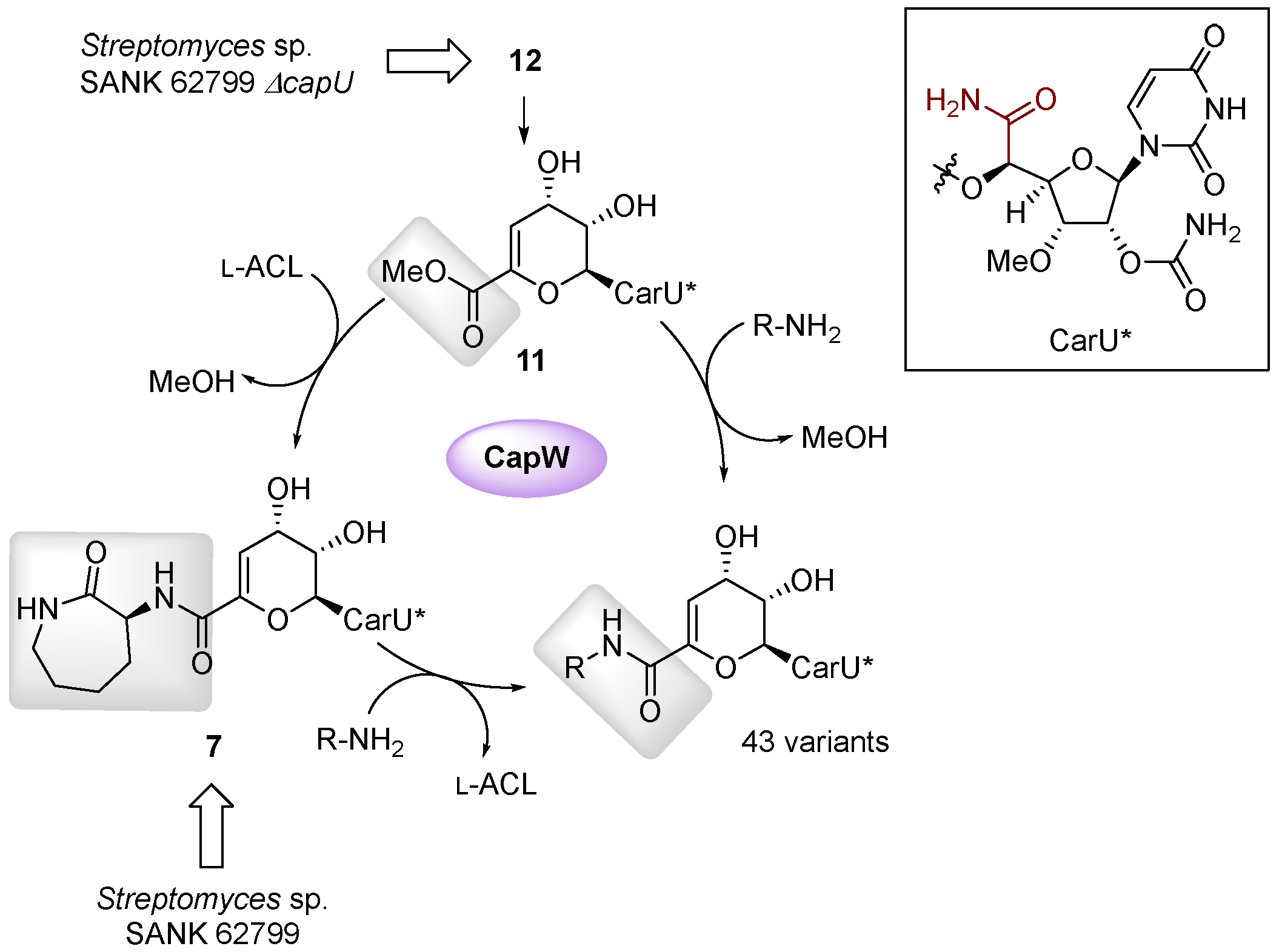
| Proposed Function | A-500359 | A-503083 | A-102395 |
|---|---|---|---|
| Fe(II)- and αKG-dependent dioxygenase | orf7 | capD | cpr18 |
| Capuramycin-2′-O-carbamoyltransferase | orf8 | capB | NA |
| Putative 3-ketoreductase | orf9 | capC | cpr20 |
| Fe(II)-dependent, αKG:UMP dioxygenase | orf10 | capA | cpr19 |
| Putative 2,3-dehydratase | orf11 | capE | cpr21 |
| Putative 4-epimerase | orf12 | capF | cpr22 |
| PLP-dependent monooxygenase-decarboxylase | orf12’ | cap15 | cpr23 |
| Putative glycosyl transferase | orf13 | capG | cpr24 |
| l-Thr:uridine-5′-aldehyde transaldolase | orf14 | capH | cpr25 |
| Putative pyrophosphatase | orf15 | capI | cpr26 |
| Putative CO dehydrogenase | orf16 | capJ | cpr28 |
| Putative O-methyltransferase | orf16’ | capK | cpr29 |
| Putative CO dehydrogenase | orf17 | capL | cpr30 |
| Putative CO dehydrogenase | orf18 | capM | cpr31 |
| Putative ABC transporter | orf19 | capN | NA |
| Putative ABC transporter | orf20 | capO | NA |
| Capuramycin 3′′-phosphotransferase | orf21 | capP | cpr17 |
| UDP-glucose-4,6-dehydratase | orf22 | capQ | NA |
| Glucose-1-phosphate thymidylyltransferase | orf23 | capR | NA |
| Putative carboxyl methyltransferase | orf24 | capS | cpr27 |
| Putative l-ACL C-methyltransferase | orf25 | capT | NA |
| Nonribosomal peptide synthetase | orf26 | capU | NA |
| Nonribosomal peptide synthetase | orf27 | capV | NA |
| Transacylase | orf28 | capW | cpr51 |
 | ||||||||
|---|---|---|---|---|---|---|---|---|
| TL1 IC50 (ng/mL) | MIC (µg/mL) 1 | |||||||
| Compound | R1 | R2 | R3 | Strain A | Strain B | Strain C | Strain D | |
| 20 | PhNH- | - | - | 6.5 | 6.25 | 16 | 4 | 8 |
| 21 | PhN(Me)- | - | - | 7.6 | 12.5 | 4 | 1 | 8 |
| 22 | 3-F-PhNH- | - | - | 10 | 6.25 | 2 | 2 | 8 |
| 23 | 4-F-PhNH- | - | - | 37 | 6.25 | 4 | 2 | 2 |
| 24 | 3,4-F2-PhNH- | - | - | 9 | 6.25 | 2 | 0.5 | 1 |
| 25 | 4-Cl-PhNH- | - | - | 18 | 6.25 | 4 | 2 | 16 |
| 26 | 4-Br-PhNH- | - | - | 20 | 6.25 | 8 | 0.5 | 8 |
| 27 | - | H | H(CH2)11CO- | n.d. | 3.13 | <0.063 | 0.125 | 0.125 |
| 28 | - | Me | H(CH2)9CO- | 550 | 6.25 | <0.063 | <0.063 | <0.063 |
| 1 | 10 | 12.5 | 8 | 8 | 8 | |||
| 2 | 10 | 6.25 | 8 | 4 | 16 | |||
| RIF 2 | n.d. | 0.125 | 0.125 | 0.25 | ||||
| IZD 3 | n.d. | 1 | 8 | 2 | ||||
© 2019 by the authors. Licensee MDPI, Basel, Switzerland. This article is an open access article distributed under the terms and conditions of the Creative Commons Attribution (CC BY) license (http://creativecommons.org/licenses/by/4.0/).
Share and Cite
Biecker, A.L.; Liu, X.; Thorson, J.S.; Yang, Z.; Van Lanen, S.G. Biosynthetic and Synthetic Strategies for Assembling Capuramycin-Type Antituberculosis Antibiotics. Molecules 2019, 24, 433. https://doi.org/10.3390/molecules24030433
Biecker AL, Liu X, Thorson JS, Yang Z, Van Lanen SG. Biosynthetic and Synthetic Strategies for Assembling Capuramycin-Type Antituberculosis Antibiotics. Molecules. 2019; 24(3):433. https://doi.org/10.3390/molecules24030433
Chicago/Turabian StyleBiecker, Ashley L., Xiaodong Liu, Jon S. Thorson, Zhaoyong Yang, and Steven G. Van Lanen. 2019. "Biosynthetic and Synthetic Strategies for Assembling Capuramycin-Type Antituberculosis Antibiotics" Molecules 24, no. 3: 433. https://doi.org/10.3390/molecules24030433
APA StyleBiecker, A. L., Liu, X., Thorson, J. S., Yang, Z., & Van Lanen, S. G. (2019). Biosynthetic and Synthetic Strategies for Assembling Capuramycin-Type Antituberculosis Antibiotics. Molecules, 24(3), 433. https://doi.org/10.3390/molecules24030433




